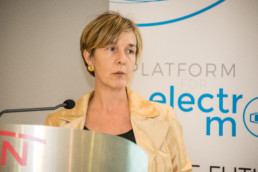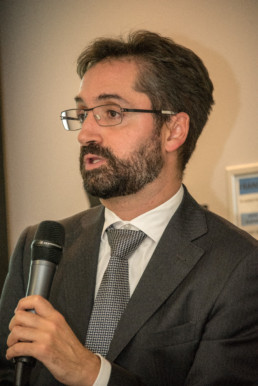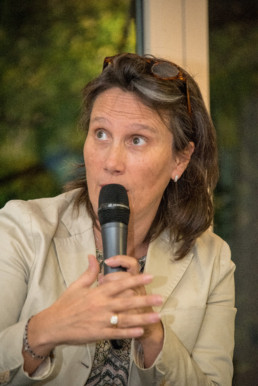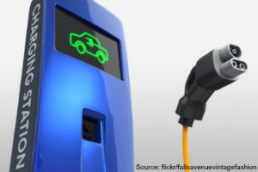Event: Leading the e-mobility transition - Time to act
Date and Time: Tue 9 October 2018, 16:45 – 19:00
Location: Thon EU, Rue de la loi 75, 1040 Brussels
Description
Europe is striving to lead the transition to a decarbonized economy and all sectors have an important role to play. CO2 emissions have decreased in all sectors with the exception of transport. An increasingly decarbonized electricity mix can contribute to the decarbonization of the transport sector, as there is no energy carrier that can curb greenhouse gas emissions to the same extent and scale as electricity.
The Clean Mobility Package can provide the regulatory framework to allow for the electrification of the transport sector, thus reducing emissions from this sector while creating new business opportunities. A high level of ambition through CO2 emission standards and ambitious public procurement practices could incentivize the transition to more sustainable vehicles, and give Europe a competitive edge in zero emission technologies internationally.
What are the economic aspects that surround electro-mobility? What technological improvements have been made? What are the new market drivers? What are the opportunities and needs in terms of new infrastructure? What are the new horizons for jobs and growth? What are the business cases and lessons for future development of electro-mobility?
Programme
- 16:45 Registration
- 17:15 Welcome remarks by Seb Dance, MEP
- 17:25 Keynote speech by Anna Lisa Boni, Secretary General, EUROCITIES
- 17.35 Presentation Climate Foundation “Trucking into a Greener Future” by Jon Stenning, Associate Director Cambridge Econometrics
- 17:50 Panel discussion and Q&A
– Giovanni Coppola, Enel X
– Marie-France Van Der Valk, Renault-Nissan
– Dario Dubolino, DG Move
– Dorothée Coucharriere, Blue Solutions
– Moderator: Greg Archer, Transport & Environment
- 18:55 Closing remarks by Seb Dance, MEP
- 19:00 Networking cocktail
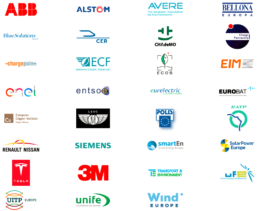
Enough public chargers planned; infrastructure can’t be blamed for the slow uptake of EVs – analysis
Enough public chargers planned; infrastructure can’t be blamed for the slow uptake of EVs – analysis
More investment in public charging infrastructure needed after 2020 as electric vehicle sales increase.
Contrary to mainstream belief that there are not enough electric vehicle chargers and that this is discouraging potential EV buyers, a new analysis reveals sufficient public recharging facilities for the number of cars on the road in 2017 in many countries. Furthermore, if national EV infrastructure roll-out plans are met there will also be sufficient EV chargers until 2020.
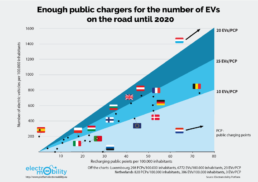
The analysis by the Electromobility Platform [1] confirms that for passenger cars it is not the lack of infrastructure but rather the limited availability of electric vehicles that is responsible for low vehicles sales – 1.4% of new car sales in the EU in 2017. The Electromobility Platform is a partnership uniting organisations from across civil society, industries, and transport modes to promote the shift to all forms of electric transport.
The analysis found that on average there were five electric vehicles on the road per public charging point in 2017 in Europe, more than recommended by the European Commission [2]. However the European average ratio masks locations of over and under supply where further investment is needed.
If EU countries deliver on their plans for the roll-out of public charging infrastructure there will be around 10 EVs per charger by 2020, also in line with the Commission target. But further investment in public charging points (PCPs) will be required both before and after 2020 as electric vehicle sales increase.
Marie-France van der Valk, Head of the Brussels Renault-Nissan Alliance Office and Chairwoman of the Platform for Electro-mobility, said: “The European Member States are taking the right turn on electro-mobility and the EV market is starting to develop in an encouraging way. But full electro-mobility momentum can only be achieved together, with all of the EU members taking real initiatives for more infrastructure, green public procurement and actively supporting the shift to a low-carbon economy.”
The Platform analysis also shows that there will be at least one high power charging station every 40km on key European highways, a continental road network known as the TEN-T Comprehensive network, by 2020. This is more than the Commission’s recommendation of one charging station every 60 km. However, beyond 2020 increased numbers of charging points will be needed in some locations.
Electromobility not only helps drastically reduce climate-changing emissions from vehicles, but is also crucial to cut noise and air pollution levels in urban areas. Public authorities can provide a lead in supporting the shift to zero-emission transport and should be encouraged and supported to do so.
Nicolas Erb, Director of European Public Affairs for Alstom and Vice-Chair of the Platform, said: “By setting national targets for the public procurement of clean vehicles by 2025 and 2030, the directive currently being discussed in Parliament and Council is a major opportunity to boost zero-emission vehicle operations in European cities. Electric buses, taxis and delivery vehicles will help tackle the air pollution crisis in European cities and provide a market for clean European vehicles, strengthening the competitiveness of our industry.”
The Electromobility Platform will present the key findings of its new analysis today in a public event in the European Parliament at 5pm (Brussels time), in the presence of the Transport Commissioner Violeta Bulc.
Matthijs van Miltenburg MEP, host of the Platform event, said: “Europe needs to be a climate and technology leader. Electromobility helps achieve both strategic objectives. Europe should set a suite of ambitious policies to drive the economic and environmental benefits electromobility offers.”
Footnotes:
[1] The Platform for Electro-Mobility is an European alliance of 31 producers, infrastructure managers, operators, transport users, cities and civil society organisations from across industries and transport modes. The Platform advocates the acceleration of electrification of all modes of transport. The vision of the Platform for Electro-mobility is a sustainable, multimodal transport system in which people and goods are predominantly moved across land in Europe using sustainable electricity.
Current Members of the Platform: ABB, Alstom, Avere, Bellona, BlueSolutions, CER, CHAdeMO, Change Partnership, ChargePoint, European Cyclists Federation, ECOS, EIM, Enel, ENTSO-E, EURELECTRIC, Eurobat, European Copper Institute, London EV Company, Polis, RATP, Renault-Nissan, SmartEn, Siemens, SolarPower Europe, Tesla, 3M, Transport & Environment, UFE, UITP, Unife and Wind Europe.
[2] The European Commission recommends 10 EVs per public charging infrastructure, but this ratio will vary widely between locations and in particular whether private parking is available.
One million electric vehicles just around the corner – What next?
One million electric vehicles just around the orner - What next?
In the coming months, Europe is to pass the 1 million electric vehicles mark. Considering EVs were virtually absent from the market half a decade ago, this is a stunning achievement which must not hide the fact that electrification of transport will still require some support from policy makers in the coming years.
The European Commission’s mobility package, with the revision of the Clean Vehicles directive, an action plan for the deployment of alternative fuels infrastructure and new emission standards for cars and vans is a unique opportunity to lift obstacles to EV purchase.
During this event, speakers discussed the current status of EV deployment in the EU, and shared their insights on what still holds down consumers from switching to electric cars, where and how to deploy a charging infrastructure and what European policy-makers can do to support the transition towards electro-mobility.
Date: Tuesday, February 27, 2018 from 4:30 PM to 7:30 PM (CET)
Place: European Parliament, Member’s restaurant, Brussels
Programme
- 16:30 Registration
- 17:00 Welcome address, Matthijs van Miltenburg, MEP
- 17:10 Introduction, Marie-France van der Valk, Chair of the Platform for Electro-mobility
- 17:20 Keynote speech, Violeta Bulc, Commissioner for Transport
- 17:30 Panel debate and Q&A with the audience – Can the EC transport package keep the momentum for electro-mobility?
Moderator: Greg Archer, Director Clean Vehicles, Transport & Environment
– Monique Goyens, Director General, BEUC
– Raphael Görner, Vice President Power Infrastructure, ABB Germany
– Benjamin Bailly, e-Bus Director, Alstom
– Umberto Guida, Director Research and Innovation, UITP
– Tina Zierul, Senior Director Public Policy, Chargepoint
- 19:00 Networking Cocktail
The Platform for Electromobility
Press release on EPBD
Platform for Electro-Mobility reaction to Council position on EPBD
EU ministers have agreed on a common approach to the revision of the Energy Performance of Buildings Directive (EPBD). The European Commission’s legislative proposal for the EPBD introduced obligations for EU countries to ensure adequate and future-proof pre-equipping of buildings for electric vehicle (EV) recharging points.
These obligations have, however, encountered strong resistance from EU Member States due to concerns over costs and potential negative impacts on renovation incentives, and have as a result been watered down. While this lowered level of ambition is regrettable, core elements remain in place and it will now be up to the European Parliament to strengthen these as it gets closer to finalising its own position.
A spokesperson for the Platform for Electro-Mobility said: “Pre-equipping buildings for the installation of smart EV charging points is crucial to satisfy EV charging needs and foster the wider uptake of electro-mobility. In fact, 90% of the electricity charged by an EV during its lifetime actually takes place in the private domain.”
The ability of charging infrastructure to control the charging process is crucial for integrating high numbers of EVs into the electricity system and contributes to optimising the energy use of buildings. Therefore, the directive should require the installation of smart charging points, which should be considered part of the building's technical equipment and included in the ‘smartness indicator’.
When it comes to non-residential buildings, the Council compromise text retains the obligation for new and substantially renovated buildings with more than 10 parking spaces to install at least one recharging point, together with ducting infrastructure [1] for at least one in every three parking spaces.
Ducting infrastructure is a future-proof and cost-effective solution, the installation cost of which is minimal as compared to the total cost of constructing or renovating a building. By comparison, failure to ensure ducting infrastructure would entail costs up to nine times higher if a building is to be retrofitted at a later stage. In light of this, the Platform for Electro-Mobility supports an extension of ducting infrastructure requirements to all parking spaces, which has already been taken on board by Council in the case of residential buildings.
On a more positive note, the Platform acknowledges the Council’s insertion of obligations to facilitate deployment of recharging points in existing buildings. Today, long and uncertain approval procedures act as a major barrier for owners and tenants to deploy charging points in shared residential and commercial buildings. If these hurdles are not removed, putting in place ducting infrastructure cannot have its full positive impact. Such ‘right to the plug’ measures have already been successfully implemented in various EU countries including Spain, France, and Portugal.
The spokesperson concluded: “All eyes now turn to the European Parliament, which is set to agree its final position in November before entering negotiations with governments and the European Commission. Strengthening this directive offers a once-in-a-decade opportunity to ensure European buildings’ readiness for the mobility needs of tomorrow.”
The Platform for Electro-Mobility is an alliance of organisations from across industries and transport modes representing manufacturers, infrastructure managers, operators and users of all types of vehicles as well as cities, civil society and other stakeholders. It shares a vision of electro-mobility for surface transport delivered through multiple modes including electric bikes, cars and vans, trucks, buses, rail and other public transport. The Platform has been created to drive forward this transformation.
Note to editors:
[1] Also referred to as ‘pre-tubing’ or ‘conduits’ to enable the later installation of EV recharging points.


